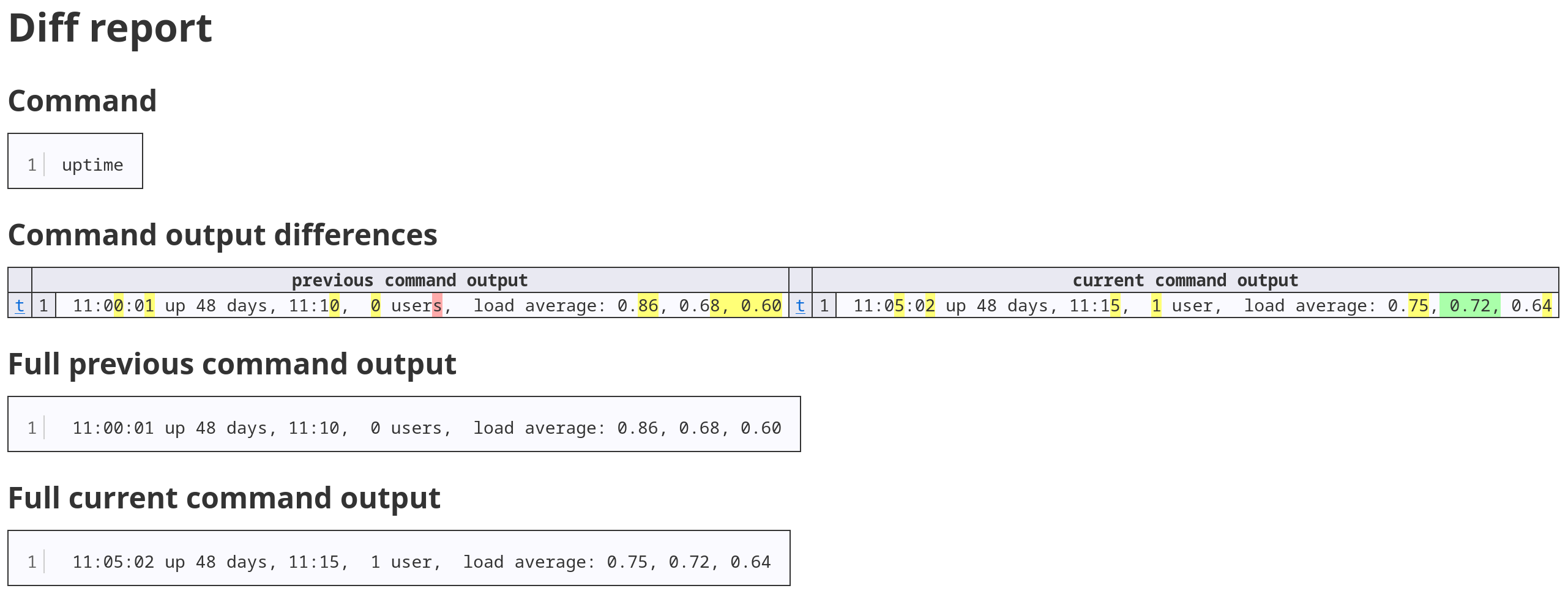dwatch (diff watch) is a tool to monitor the output of a given command and notify the user on changes by sending an email with a diff view.
dwatch is available on PyPI and can be installed with pip:
python3 -m pip install dwatchAt least Python 3.6 is required.
If you run an Arch-based system, you can also install dwatch from the
AUR:
yay -S dwatchYou can also download self-contained executables (no Python installation required) for Linux x64 and macOS x64 from the releases page.
By default, dwatch runs a commmand passed on the command line every 60 seconds and notifies the user on any changes. You can run a first test with:
dwatch -i 2 --stdout "date"This runs the date command every 2 seconds and prints the output differences to stdout.
Pass the --run-once option to run one check, print a diff if necessary and exit. The diff is created against the
output from the previous run (command outputs are stored in the file ~/.dwatch_command_output.json). This is
especially useful in cron jobs.
Without --stdout the diff output is sent as an HTML email. By default, dwatch uses the sendmail tool for this, which
is available if a local email server like Postfix or Exim is installed or if a simple mail forwarder like
ssmtp is present. As an alternative, dwatch supports direct communication
with a mail server with Python's builtin smtplib. This can be used if
no email server is installed locally. In either case, run
dwatch --write-default-configto create a default configuration file at ~/.dwatchrc. Open the file with a text editor and configure a sender
from_address and receiver to_address in the [mail] section:
[mail]
backend = sendmail
server = mail.example.com
login_user = jane.doe
login_password = xxx
encryption = starttls
from_address = [email protected]
to_addresses = [email protected]
Change sendmail to smtplib to use an arbitrary email provider and set the server address, the login credentials and
the encryption (none, starttls or ssl). If none is chosen, no login credentials are sent for security reasons.
This can only be used for very simple mail server setups.
Use the --description command line option with a text argument to add a description to the diff report and the subject
field of emails. This can be useful to distinguish different commands.
These options can be configured in the file ~/.dwatchrc:
-
[general]section:verbosity: The logging level of the application. Can be one ofquiet,error,warn,verboseordebug.
-
[mail]section:backend:sendmailto use the localsendmailcommand orsmtplibto connect to an arbitrary email server with the smtp protocol.server: The mail server to use. This field is ignored if thesendmailbackend is chosen.login_user: The login name for the mail server. This field is ignored if thesendmailbackend is chosen.login_password: The login password for the mail server. This field is ignored if thesendmailbackend is chosen.encryption: The encryption to use to connect to the mail server, can benone(not recommended!),starttlsorssl. This field is ignored if thesendmailbackend is chosen. Ifnoneis chosen, no login credentials are sent for security reasons.from_address: The from address in the email envelope. Many providers do not support to change the from address and overwrite this with your actual mail address.to_address: The recipient address.
-
[watch]section:interval: The time interval in seconds between runs of the given command.run_once: If set toTrue, the command will only be run once the program exits. This is intended to be used with cron jobs.shell: Run the given command in a subshell. This is useful to allow shell patterns in a command like pipes (for examplecommand | grep pattern).
usage: dwatch [-h] [-d DESCRIPTION] [-i INTERVAL] [-o | -O] [-s | -S]
[--stdout] [-V] [-w] [-q | --error | --warn | -v | --debug]
[command]
dwatch is a tool for watching command output for changes and notifiying the
user. Default values for command line options are taken from the config file
at "~/.dwatchrc"
positional arguments:
command the command to watch
options:
-h, --help show this help message and exit
-d DESCRIPTION, --description DESCRIPTION
add a description which is added to the diff output
and used in the e-mail subject
-i INTERVAL, --interval INTERVAL
set the interval for the watched command (default:
"60.0")
-o, --run-once run the given command once and exit (default: "False")
-O, --no-run-once don't run the given command once and exit (default:
"True")
-s, --shell run the given command in a shell subprocess (default:
"False")
-S, --no-shell don't run the given command in a shell subprocess
(default: "True")
--stdout print the diff on stdout, do not send a mail
-V, --version print the version number and exit
-w, --write-default-config
create a configuration file with default values
(config filepath: "~/.dwatchrc")
-q, --quiet be quiet (default: "False")
--error print error messages (default: "False")
--warn print warning and error messages (default: "False")
-v, --verbose be verbose (default: "True")
--debug print debug messages (default: "False")

